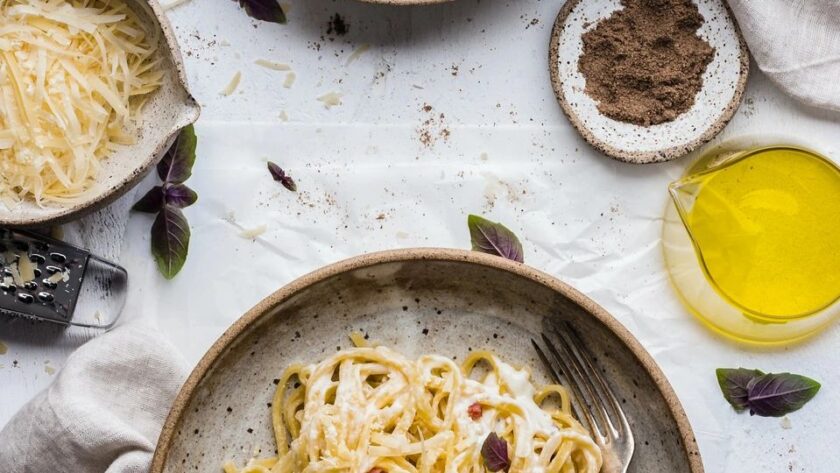Pasta is one of the most perfect foods on the planet; easy to cook, endlessly versatile, and basically impossible to mess up. But if you’ve ever wondered whether fresh pasta is actually better than dried, why some sauces pair better with certain shapes, or how to step up your pasta game beyond boiling water and dumping in a jar of sauce, this guide is for you.
This is Pasta 101; a breakdown of everything you need to know about fresh and dried pasta, what sauces go with what shapes, and a few pro tips to make sure your pasta game is as strong as possible.
Fresh Pasta vs. Dried Pasta: What’s the Difference?
Fresh and dried pasta aren’t just different versions of the same thing; they serve completely different purposes in the kitchen. Knowing when to use each can take your pasta dishes from good to restaurant-quality.
Dried Pasta: The Workhorse
- Made from semolina flour and water, then extruded and dried for long shelf life.
- Firm, chewy texture that holds up well to hearty, chunky sauces.
- Best for dishes that require a longer cook time, like baked pasta, carbonara, or bolognese.
- Comes in hundreds of shapes, each designed to pair with different types of sauces.
- Can be stored in your pantry for basically forever.
Fresh Pasta: The Delicate One
- Made from flour and eggs, giving it a rich, silky texture.
- Tender, delicate, and soaks up sauce beautifully.
- Best for lighter, more delicate sauces like butter-based, creamy, or simple tomato sauces.
- Requires a little effort to make, but the payoff is huge.
- Cooks in 1-3 minutes and is best eaten immediately.
What Pasta Shape Goes With What Sauce?
Not all pasta shapes are created equal. Some are built to hold onto thick sauces, while others are best for light, silky coatings. Here’s how to match your pasta with the right sauce so you don’t end up with a plate of disappointment.
Long, Thin Pastas (Spaghetti, Linguine, Fettuccine, Tagliatelle)
- Best for smooth, oil-based, or creamy sauces that coat the noodles evenly.
- Think: Garlic and olive oil sauces, Alfredo, carbonara, simple tomato sauces.
- Avoid chunky sauces; big pieces of meat or veg won’t cling well to these.
Tube Pastas (Penne, Rigatoni, Ziti, Paccheri)
- Designed to hold onto thick, hearty sauces inside their hollow centers.
- Think: Bolognese, vodka sauce, thick tomato sauces, baked pasta dishes.
- Avoid thin sauces; too much slips off, leaving you with bland bites.
Twisted & Ridged Pastas (Fusilli, Rotini, Gemelli, Cavatappi)
- The ridges and spirals grab onto sauce like crazy, making them perfect for pesto and creamy sauces.
- Think: Pesto, mac and cheese, thick cream-based sauces.
- Avoid super-light sauces; these shapes work best when fully coated.
Stuffed Pastas (Ravioli, Tortellini, Agnolotti)
- Best with light butter or broth-based sauces that don’t overpower the filling.
- Think: Brown butter sage sauce, light tomato broths, simple cream sauces.
- Avoid chunky sauces; too much going on will drown out the filling.
Tiny Pastas (Orzo, Ditalini, Pastina, Israeli Couscous)
- Best in soups, salads, or light butter-based sauces.
- Think: Minestrone, pasta salads, simple lemon-butter dishes.
- Avoid thick sauces; these little guys will just disappear in them.
How to Cook Pasta Like You Actually Know What You’re Doing
You’ve boiled pasta a million times, but if you’ve been draining it in a colander and rinsing it with water, we need to talk. Follow these steps and you’ll instantly improve any pasta dish.
1. Salt Your Water Like the Ocean
- The biggest mistake people make? Not salting their water enough.
- Add at least 1-2 tbsp of kosher salt per gallon of water.
- Properly salted water = properly seasoned pasta, period.
2. Don’t Break the Pasta
- Spaghetti sticking out of the pot? Just wait 30 seconds, it’ll soften and fold in.
- Breaking it before cooking ruins the whole texture.
3. Save Some Pasta Water
- That cloudy, starchy water? Liquid gold.
- Add a splash to your sauce before tossing the pasta in; it helps thicken and bind everything together.
4. Undercook It Slightly, Then Finish in the Sauce
- Drain pasta when it’s still slightly firm (al dente).
- Toss it in the sauce for the last 1-2 minutes of cooking so it absorbs all that flavor.
5. Never Rinse Your Pasta
- Unless you’re making pasta salad, never rinse.
- Rinsing washes away starch, which helps sauce cling better.
What About Gluten-Free or Alternative Pastas?
If you’re going gluten-free or looking for something different, there are plenty of solid options out there:
- Chickpea or Lentil Pasta – Higher protein, slightly firmer texture, great for hearty sauces.
- Brown Rice or Quinoa Pasta – Closer to traditional pasta in texture, good for most sauces.
- Zucchini Noodles (Zoodles) – Not technically pasta, but works well with light, oil-based sauces.
- Homemade Gluten-Free Pasta – You can make it from scratch using a mix of gluten-free flours for the best texture.
The Bottom Line: Pasta Is Simple, But It Can Always Be Better
Whether you’re sticking to dried pasta or going all-in on fresh, cooking it right and pairing it with the right sauce makes all the difference. Know when to use each type, match your pasta with the right sauce, and for the love of carbs, salt your water.
Want to try making fresh pasta? Check out my Fresh Pasta Recipe. Need a killer sauce? Start with my Weeknight Tomato Sauce. Whatever you do, just don’t settle for soggy, bland noodles ever again.



